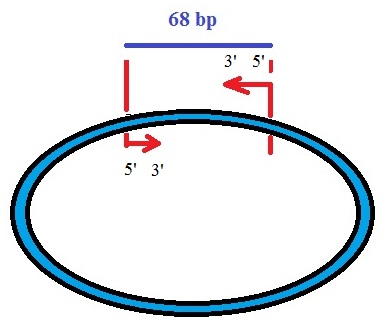Synthesis of circular oligonucleotides
The control of biomolecular functions has become an important research subject in biology and biomedicine in recent years. Chemical approaches useful for this type ofr research often utilize different types of synthetic oligonucleotides such as circular oligonucleotides, either modified or unmodified. The ligation-during-amplification (LDA) reaction can be used for the synthesis of circular oligonucleotides.
The polymerase chain reaction (PCR) is a technique that allows amplification of nucleic acids in-vitro. However, the reaction produces linear products. Many forms of DNA that are competent to duplicate, copy, or reproduce DNA contain closed circular deoxyoligonucleotides (DNA). Until the introduction of thermostable ligases, these molecules could only be amplified in-vivo in the appropriate host cells.
Since the introduction of the ligation-during-amplification (LDA) reaction, in-vitro synthesis of closed circular DNA is possible without the need for subcloning. Chen and Ruffer in 1998 elegantly showed how to do this. In their paper, the two scientists describe an in-vitro procedure for the selective amplification of closed circular DNA using sequence-specific primers.

Figure 1: Amplification of closed circular plasmids via the ligation-during-amplification (LDA) method. The graphic illustrates the primer configuration utilized during the amplification. The open arrows represent the primers. For site-directed mutagenesis, mutagenic primers can be used.
Chen and Ruffer demonstrated that LDA is a very useful method for site-directed mutagenesis, mutation detection, DNA modification, DNA library screening and the production of circular DNA. LDA uses a thermostable DNA ligase during the PCR reaction in which a circular DNA serves as the template. After a primer is fully extended along the circular template, the ligase closes the gap. This closing of the gap results in a double-stranded circular DNA. Thermal denaturation separates the two circular DNA strands that can now serve as the template for the next round of extension and amplification. The use of thermal cycling allows the exponential amplification of closed circular DNA.
Chen and Ruffer used a circular plasmid of 1990 base pairs (bp), and two 5’ phosphorylated primers,16 and 17 nucleotides (nt) long, for the generation and amplification of closed circular DNA. The primers used were complementary to different strands of the plasmid. The primers, one containing a single G to A mismatch on an HphI site, were applied in the plasmid in an inward orientation. The reaction products were analyzed using agarose electrophoresis and tested for their function by their ability to transform bacterial cells. The scientists reported that the yields of transformation was very high. The researchers concluded that LDA can be used to amplify replicatively competent closed circular DNA directly from other circular DNA, such as circular plasmids, using sequence-specific primers without the need for subcloning.
Reference
Z Chen, D E Ruffner; Amplification of closed circular DNA in vitro. Nucleic Acids Res. 1998 February 15; 26(4): 1126–1127.
Patent: 6620597, "Method for in vitro amplification of circular DNA", Chen, Zhidong (Salt Lake City, UT), Ruffner, Duane E. (Salt Lake City, UT), 2003, September, http://www.freepatentsonline.com/6620597.html